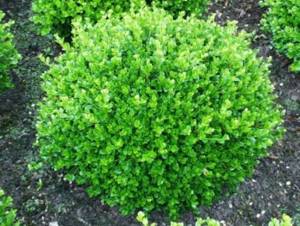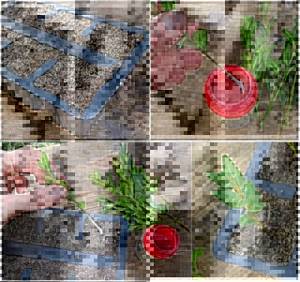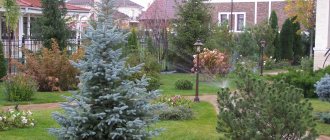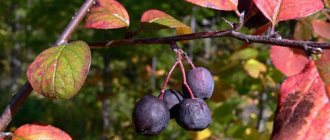Types and varieties
- Boxwood evergreen . The homeland of the plant is the territory of the Caucasus and the Mediterranean. The tree does not tolerate frost well, so it requires additional protection in winter. Popular varieties Elegance, Suffruticosa.
- Small-leaved . The dwarf shrub, which is not afraid of frost, tolerates low temperatures well – from minus 25 °C. This type of buxus is often planted in the countryside, because it is unpretentious in care. Popular varieties are “Faulkner” and “Winter Jam”.

- Balearic . It is considered one of the largest, fastest-growing shrubs, the size of its leaves can reach a length of 4-5 cm.

Boxwood propagation
Boxwood can be propagated quite successfully, both from seeds and cuttings. Regardless of which cuttings are used for propagation: summer or winter (lignified), the survival rate is quite high and can reach from 80 to 100.
The beginning of summer cuttings depends on the lignified base of young shoots, which usually occurs from the second half of June to the second half of July. Before the onset of the growing season, during spring pruning it is necessary to prepare lignified cuttings, and cut autumn cuttings in late summer - early autumn. The cut cuttings must be at least 5-10 cm in length and have at least 2-3 internodes. The prepared cuttings should have no more than 2 upper leaves, and the lower leaves should be completely removed, after which it should be placed in soil obtained by mixing equal parts of the earth with peat and covered with plastic wrap or a glass jar.
It is advisable to water the planted cuttings every other day and do not forget to spray. After a month, the cuttings take root, and with the onset of autumn they should be assigned to a permanent place of residence, insulated for successful wintering. Propagation by seeds takes quite a long time and requires a lot of patience due to the fact that the evergreen plant itself is a slow-growing one, so many gardeners prefer cuttings or purchasing ready-made planting material.
Boxwood is a wonderful decoration not only for a garden plot, but also for a city apartment. It looks great as a green border, hedge, picturesque arch or gazebo, and topiary figures can turn a site into something extraordinary. For its magnificent thick “hair”, which, through cutting, allows the bushes to be given various shapes, and then preserved for a long time, boxwood is among the favorites of designers who are involved in the design of green beauty in our homes, winter gardens or country courtyards.
Thanks to its unpretentiousness and unpretentiousness, evergreen boxwood growing in a personal plot is an excellent choice, because a bright and very attractive plant, with the vibrant shine of green leaves, can brighten up the most cloudy day, fitting well into the interior around you.
Useful article? Share with your friends:
Planting boxwood in open ground
In most cases, the shrub is placed on the lawn, garden or front garden in the form of a hedge. It serves as a protective and decorative border.
Procedure for planting boxwood:
- Choice of soil and location.
- Preparing the planting hole.
- Watering and forming an air cushion from perlite granules mixed with soil.
- Distribution of rhizomes along the bottom of the pit.
- Backfilling the soil, re-watering and compacting.
Soil selection
For boxwood, it is better to choose clayey, loose, fertile soil. Soil with a neutral or slightly alkaline pH is considered ideal. If it is not rich in minerals, the plant will grow slowly. Take care to choose a place with optimal humidity.
If the water in the area constantly stagnates, the root system of the boxwood may die, then instead of open ground it is better to plant the plant in a pot or container.
Place and timing of landing
Place boxwood shrubs in the shade. In the open sun, the foliage of the plant will lose its attractive appearance and become dull and faded. In the first week after planting or transplanting, cover the bush with fabric or film so that the plant experiences less stress and takes root better. The optimal time for rooting boxwood is the period from the second half of September to the beginning of October. Before the first frost, the plant will take root and adapt normally. If you plant a shrub in the spring, protect the tree from direct sunlight and provide reliable watering.
Distance between bushes
If you plan to make a hedge, place the seedlings at a distance of 20-25 cm from each other. For a continuous carpet, dig holes in a checkerboard pattern, maintaining an interval of 15-20 cm between them.
Planting and care
Despite the established opinion that boxwood can only be grown in the south, lovers of this crop have proven that this shrub can be successfully grown in central Russia. The main thing is to follow the rules of planting and care, and choose the variety wisely. Growing evergreen boxwood largely depends on the choice of location, the winter hardiness of the variety, and its hardiness.
When choosing a location, it is better to give preference to clay soil with good water permeability. Too salty, swampy and heavy soils are completely unsuitable for growing evergreen boxwood. You can prepare your own soil mixture for growing buxus. To do this, you will need 2 parts of deciduous soil, one part of coniferous soil, one part of sand, and a little birch charcoal.
Boxwood is planted to decorate a garden plot, so the choice of location depends on the composition that the designer plans to create, the growth rate of the plant, its relationship to the sun and shade. To create hedges, varieties are used that grow for a long time and do not depend on the influence of sunlight.
In any case, for boxwood to take root and grow well, it must be planted correctly. To do this, you need to prepare the bush in advance. The day before it is removed from the ground, it is thoroughly watered so that the procedure for the plant is easy and painless.
You need to dig a hole three times larger than the earthen ball. Pour a layer of drainage mixture at the very bottom, about 3-4 cm. The roots are straightened in order to accelerate the growth rate, treated with a root accelerator, then placed in a recess. Next, you need to fill the hole with soil and perlite in equal proportions, compact it, and water it. After a week, it is necessary to water the transplanted bush again if there has been no rain during this time.
Caring for evergreen boxwood depends on the season. In winter, you need to shake off the snow accumulated on the branches to protect them from breaking. In dry and frost-free winters, the tree is provided with watering so that the evergreen leaves do not dry out.
Boxwood does not like sudden changes in weather, when after cloudy winter days the spring sun shines too brightly. The root system is still sleeping, but the branches are beginning to reach for the sun's rays. To prevent the branches from drying out, it is recommended to cover the tree for this period of time.
It is best to water and feed the plant with fertilizers in the spring. The most optimal composition for this species is potassium, phosphorus, and nitrogen. The first time feeding is carried out in March, then the procedure is repeated every two weeks.
It is recommended to trim evergreen boxwood in the summer. It is better to water abundantly at the same time. In hot weather, it is better to do this in the evening, when the sun is no longer burning. Dusty leaves need to be washed occasionally by watering using the irrigation method.
How to care for boxwood
If you choose the ideal location and soil for the plant, there will be no difficulties in growing it. Boxwood is easy to care for, tolerates hot weather without consequences, and is also resistant to low temperatures, withstanding frosts down to minus 20 °C. To make the bushes grow comfortably, protect them from strong winds and drafts.
Features of watering
Boxwoods themselves are drought-resistant, so it is not recommended to irrigate them regularly. Water the bushes only when there is no rainfall for a long time. A bush with a height of 1 meter should require 10 liters of water. During the dry period, do not increase the frequency of watering, just provide the plant with a sufficient amount of liquid. If a lot of dust appears on the leaves, install a sprinkler to wash away the dirt and clean the plants.
Loosening the soil and mulching
For boxwood growing in open ground, natural air exchange of the rhizome is important. When caring, periodically loosen the soil to prevent crusts from forming. As soon as the ground warms up after winter, mulch. To do this, scatter peat at a short distance from the branches and trunk. Make sure that the substance does not come into contact with young shoots or leaves.
Feeding with fertilizers
In open ground, the bush needs regular feeding, especially with frequent cuttings. To feed, use special mineral fertilizers intended for evergreen plants. In spring and summer, choose complexes enriched with nitrogen and phosphorus. In the fall, feed the plant with superphosphate and potassium salt. When preparing the solution, strictly follow the instructions so as not to harm the plant or burn the roots or trunk.
Trimming
The first cutting of the bush is done 2 years after planting in open ground. During this time, the rhizome will strengthen well. If the boxwood is short, you can trim it 2-3 weeks after planting, carefully removing the top.
Types of boxwood pruning:
- Spring . Perform a haircut before active growth begins. Start trimming the bush from the top, gradually moving downwards.
- Autumn . The optimal time for pruning is the end of October or the beginning of November, when the bush stops actively growing and there are no serious frosts yet. In the fall, young shoots are also pruned to stimulate their growth in the next spring season. In this case, cut off no more than 2 cm.
Perform a topiary trim in early spring, before the plant begins to actively grow. To beautifully form a spherical crown or a cube, pyramid, cone, or other shapes, you can use stencils and slats. They will serve as a template, ensuring the edges are even and symmetrical.
Propagation of boxwood by cuttings

This is the most affordable and convenient way to plant seedlings at home. Prepare cuttings for propagation in mid-spring, with planned pruning at the end of June or September. For convenience and safety, use garden pruners.
Procedure:
- Cut cuttings 10-15 mm long.
- Make the bottom cut at an angle to increase the area for root formation.
- Soak the prepared branches in a rooting stimulator for a day to stimulate rooting.
- Plant the strong cuttings in the ground.
Watering and fertilizing boxwood
Boxwood is a plant that is not particularly demanding of watering, but in dry weather it needs additional moisture, and also very favorably accepts spraying of the crown, especially in young plants. Experts advise that when planting seedlings in soil that is not rich in useful substances, add humus and humus, and for plants in flowerpots use special fertilizers for boxwood - a liquid that is simply diluted with water and added to the soil no more than once every 10 days, starting from the second half of April and ending at the beginning of August.
When preparing boxwood for wintering, it is necessary to feed it in the fall with fertilizers containing potassium, which accelerates the lignification of shoots and increases the plant's resistance to frost. Do not forget to fertilize the shrub in early spring before the leaves appear, with fertilizing containing nitrogen; alternatively, you can dilute 1 kg of mullein, 15 grams of urea or 25 grams of ammonium nitrate in 10 liters of water and fertilizers with minerals obtained from 20 g of nitroammophoska diluted in 10 liters of water .
Diseases and pests
The most dangerous parasite for shrubs is the boxwood moth. As soon as it gets warmer outside, the caterpillar lays eggs in the young leaves of the egg plant. The hatched larvae bite into the crown and remain there to overwinter. The following spring, adult individuals emerge from them and actively reproduce. If there are a lot of pests, the plant dries out and dies. If you find a boxwood moth on a tree, immediately treat it with an insecticidal agent.
A common buxus disease is shoot necrosis, which is caused by the fungus Volutella buxi. First, orange and pink spots appear on the leaves, then the tops of the stems dry out. Antifungal agents do not solve the problem, so wilted shoots must be removed. Sometimes boxwood gets cancer. To combat it, the affected areas are removed, and the sections are treated with Fundazol.











